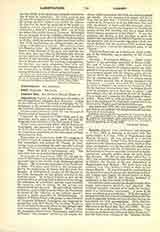

Lamoignon, FAMILY OF, illustrious in the history of the old magistracy, originally from Nivernais. Owing to the nearness of the University of Bourges, the Lamoignons, in the sixteenth century, had the benefit of the excellent juridical instruction given there.
CHARLES DE LAMOIGNON (1514-73) was the pupil of the renowned jurisconsult Alciat.
CHRETIEN DE LAMOIGNON (1567-1636), son of the preceding, was a pupil of Cujas. Both this and the foregoing were members of the Parlement of Paris.
MARIE DES LANDES (1576-1651), wife of Chretien de Lamoignon, was associated in work with St. Vincent de Paul, who called her the mother of the poor; and she founded an association for the deliverance of those imprisoned for debt.
MADELEINE DE LAMOIGNON (1609-87), daughter of Chretien, whom St. Francis de Sales prepared for her first communion, also assisted St. Vincent de Paul. Owing to her cooperation the saint was able to found the Hotel-Dieu and establish the institution for foundlings. When she died, a contemporary said, “The poor have lost one hundred thousand crowns.”
GUILLAUME DE LAMOIGNON (1617-77), having become in 1644 master of requests in the Parlement, took an active part in the Fronde of the Parlement against Mazarin. He became first president of the Parlement in 1658. The great work which he did towards preparing the codification of French laws has made him famous. A distinguished member of the Society of the Holy Sacrament, he was greatly devoted to the Catholic cause. He induced Colbert to give up his cherished idea of putting back to twenty-seven the age for ordination to priesthood, and the years required for monastic vows to twenty for the women and twenty-seven for the men. He had certain Gallican tendencies, and in 1663 he spoke before the Parlement in favor of the “liberties of the Gallican church” against a thesis suspected of ultramontanism. A nephew of Bishop Potier of Beauvais, a close friend of the Jansenist Hermant, Lamoignon was supposed to sympathize with Port Royal, but he chose Rapin, a Jesuit, as tutor for his sons, whom he also brought into close acquaintance with Bourdaloue. When in 1664 the Jansenists deferred to the Parlement a confutation of Pascal’s “Provinciales” written by the Jesuits, the decree which condemned this book nevertheless spared the Jesuits. On this occasion Lamoignon said to the king that he had been “a witness of the unfair out-bursts of the Jansenists in all the differences they had with the Society of Jesus; and this Jansenist party, which was being formed in the kingdom on the dissemination of the new teaching, was but a cabal which would become pernicious to the State”. It was Lamoignon who, having as first president to settle the dispute that had arisen at the Sainte-Chapelle between the precentor and the treasurer regarding a desk, furnished Boileau with the account of this incident from which the latter evolved the celebrated poem of the “Lutrin”.
CHRETIEN-FRANVOIS DE LAMOIGNON (1644-1709), son of the foregoing, was a member of the French Academy.
NICOLAS LAMOIGNON—BAVILLE (1648-1724), brother of the preceding, intendant of Poitou (1682-85), and of Languedoc (1685-1718), made himself famous by the measures he adopted against the Protestants of these provinces, and by the manner in which he associated himself with the religious policy of Louvois, of which the revocation of the Edict of Nantes was the culminating point. But it is without proofs that Voltaire accused him of having instigated this revocation. “I never counselled the revocation of the Edict of Nantes”, he wrote to his brother in 1708. On the contrary he considered that “in religion hearts must be attacked, for it is there that it resides”, and immediately after the revocation he sent for Bourdaloue to come and evangelize the Protestants of Montpellier. From 1702 to 1704 he helped in the repression of the uprising of the Camisards, occasioned in the Cevennes by English and Calvinistic influences.
MALESHERBES (1721-94), who defended Louis XVI and died on the scaffold, was the grandson of Chretien-Francois de Lamoignon.
GEORGES GOYAU

